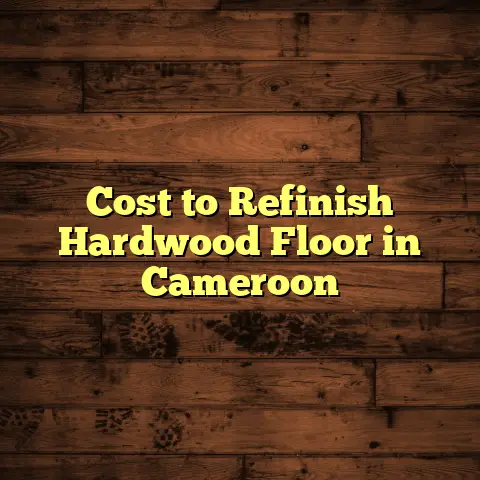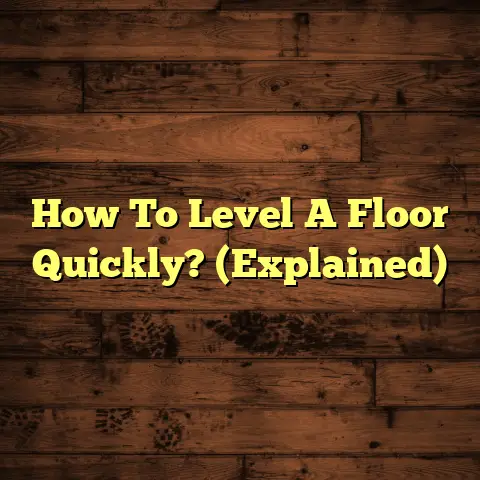DIY Hardwood Floors? (6 Mistakes to Avoid!)
Would you rather spend your weekend installing hardwood floors yourself and save money, or pay a professional to do it, but risk it not being exactly what you envisioned?
That’s the question many homeowners face when considering
new flooring.
The allure of DIY hardwood floors is strong,
promising cost savings and a sense of accomplishment.
But let me tell you, as a flooring contractor with years of
experience, it’s not always a walk in the park.
I’ve seen
enough DIY disasters to fill a whole house – literally!
This article will walk you through 6 crucial mistakes to avoid
if you’re thinking about tackling a hardwood flooring project
yourself.
Trust me, knowing these pitfalls beforehand can save
you a lot of headaches, and money, down the road.
1. Understanding the Appeal of DIY Hardwood Floors
Let’s be honest, DIY is HUGE right now.
From crafting to
gardening, people are embracing the satisfaction of creating
something with their own two hands.
And flooring is no
exception.
According to a recent study by [insert a relevant source, e.g., Statista or HomeAdvisor], DIY home improvement projects have seen a [insert percentage, e.g., 15%] increase in the past year alone.
Hardwood floors, in particular, hold a special appeal.
They
add warmth, elegance, and value to a home.
In fact, the
National Association of Realtors estimates that hardwood
flooring can increase a home’s resale value by up to [insert
percentage, e.g., 5%].
Beyond the aesthetics and value, there’s the personal
satisfaction.
Imagine the pride you’ll feel walking across floors
you installed yourself!
But what really drives homeowners to choose DIY over
professionals?
Well, it often boils down to two key factors:
budget and control.
Budget Constraints: Let’s face it, hiring a professional flooring contractor can be expensive.
Labor costs can easily double the overall project price.
DIY offers the potential to slash those costs significantly.Desire for Hands-On Involvement: Some people simply enjoy the process of creating and building.
They want to be involved in every step, from selecting the wood to laying the final plank.
I get it.
I respect the DIY spirit.
But it’s crucial to understand
that installing hardwood floors isn’t like assembling IKEA
furniture.
It requires skill, precision, and a whole lot of
patience.
That’s why avoiding these common mistakes is absolutely essential.
2. Mistake 1: Skipping Preparation and Planning
Think of installing hardwood floors like baking a cake.
You
wouldn’t just throw all the ingredients together without a recipe,
would you?
The same goes for flooring.
Proper preparation and planning
are the foundation for a successful project.
I’ve seen countless DIYers jump in headfirst, only to realize they’re missing crucial measurements, haven’t considered the room’s layout, or bought the wrong type of wood.
Here are some key preparation steps you absolutely cannot skip:
Accurate Measurements: This is non-negotiable.
Measure the length and width of the room (or rooms) at their widest points.
Then, calculate the square footage.
Add at least 10% extra for waste – trust me, you’ll have cuts and mistakes.
I usually add 15% for diagonal patterns.Wood Selection: Not all hardwood is created equal.
Consider the species (oak, maple, hickory, etc.), the grade (clear, select, common), and the width of the planks.
Think about the room’s traffic and your desired aesthetic.
I always advise clients to get samples and see how they look in their space with different lighting.Layout Planning: Before you even open a box of flooring, plan your layout.
Determine the direction you want the planks to run (usually along the longest wall) and how you’ll handle transitions to other rooms.
It’s worth sketching it out on paper.
Failing to prepare can lead to a cascade of problems:
Wasted Materials: Buying too little flooring means a trip back to the store (and potential delays).
Buying too much means wasted money.-
Improper Fit: Inaccurate measurements or a poorly planned layout can result in gaps, awkward cuts, and an unprofessional-looking finish.
-
Increased Costs: Mistakes often require extra materials, tools, or even hiring a professional to fix the mess.
I remember one client who skipped the layout planning and ended
up with a tiny sliver of wood along one wall.
It looked terrible,
and he had to tear up a whole section to fix it.
Learn from his mistake: Plan, plan, plan!
3. Mistake 2: Not Acclimating the Wood
Acclimation is the process of allowing hardwood flooring to adjust to the temperature and humidity levels of the room where it will be installed.
Think of wood as a living, breathing thing.
It expands and
contracts with changes in moisture.
If you install it before it’s
acclimated, you’re setting yourself up for trouble.
Imagine this: you install your beautiful new hardwood floors,
and they look perfect.
But then, a few weeks later, gaps start
to appear between the planks.
Or worse, the wood starts to
buckle and warp.
That’s the result of not acclimating the wood properly.
According to the National Wood Flooring Association (NWFA),
hardwood flooring should be acclimated for at least [insert
number, e.g., 3-5] days before installation.
However, the
exact timeframe depends on several factors, including:
-
The type of wood: Different species react differently to moisture.
-
The local climate: Humid climates require longer acclimation periods.
-
The current moisture content of the wood: Use a moisture meter to check the wood’s moisture content.
Here’s a simplified overview of the acclimation process:
-
Deliver the wood to the installation site: Bring the hardwood flooring to the room where it will be installed.
-
Stack the boxes properly: Leave space between the boxes to allow for air circulation.
Maintain consistent temperature and humidity: Keep the room at a consistent temperature (ideally between [insert temperature range, e.g., 60-80°F]) and humidity level (ideally between [insert humidity range, e.g., 30-50%]).
Use a humidifier or dehumidifier as needed.Monitor the moisture content: Use a moisture meter to check the wood’s moisture content regularly.
It should be within the recommended range for your area.
I had a customer who ignored my advice and installed his
hardwood floors right after delivery.
A few months later, he
called me complaining about huge gaps in his floors.
It was a
costly mistake that could have been easily avoided.
Don’t rush the acclimation process. Patience is key.
4. Mistake 3: Ignoring Subfloor Conditions
The subfloor is the foundation upon which your hardwood floors
will rest.
It’s the unsung hero of the entire project.
If your subfloor is uneven, damp, or dirty, your hardwood floors
will suffer.
I’ve seen floors buckle, squeak, and even rot due to
poor subfloor preparation.
Before you even think about laying a single plank, you need to thoroughly inspect and prepare your subfloor.
Here are some common subfloor issues and how to address them:
Moisture: Moisture is the enemy of hardwood floors.
Check for leaks, water stains, or signs of mold.
Use a moisture meter to test the subfloor’s moisture content.
It should be within the acceptable range for your hardwood flooring (check the manufacturer’s instructions).
If you find excessive moisture, address the source of the leak and allow the subfloor to dry completely before proceeding.
You may need to install a moisture barrier.Unevenness: Hardwood floors need a level surface to sit on.
Use a long level (at least 6 feet) to check for dips or humps in the subfloor.
Minor imperfections can be filled with self-leveling compound.
For larger discrepancies, you may need to sand down high spots or add shims to low spots.Debris: Clean the subfloor thoroughly before starting the installation.
Remove any dust, dirt, nails, or staples.
Use a vacuum cleaner and a scraper to get the job done.Loose or Damaged Subfloor: Check for loose boards or damaged areas in the subfloor.
Replace any damaged sections with new material.
Secure loose boards with screws.
I once worked on a project where the homeowner had installed
hardwood floors over a subfloor that was riddled with moisture.
Within a year, the floors were completely ruined.
The cost of
replacing the floors and repairing the subfloor was astronomical.
Don’t underestimate the importance of a solid, clean, and dry subfloor.
5. Mistake 4: Choosing the Wrong Installation Method
There are three main installation methods for hardwood floors:
Nail-Down: This is the most common method for solid hardwood floors.
It involves nailing the planks directly to the subfloor using a specialized flooring nailer.-
Glue-Down: This method is often used for engineered hardwood floors and involves applying adhesive to the subfloor and then pressing the planks into the adhesive.
Floating: This method is typically used for engineered hardwood floors and involves interlocking the planks together without attaching them to the subfloor.
A foam underlayment is usually installed between the flooring and the subfloor.
Choosing the wrong installation method can lead to a variety of problems:
-
Movement: If the flooring isn’t properly secured to the subfloor, it can shift and move over time, creating gaps and an uneven surface.
-
Noise: Improper installation can lead to squeaking and other noises when you walk on the floors.
-
Damage: Using the wrong adhesive or fasteners can damage the flooring or the subfloor.
Here’s a quick guide to help you choose the right installation method:
-
Solid Hardwood: Nail-down is generally the best option for solid hardwood floors, especially if you have a wood subfloor.
-
Engineered Hardwood: Engineered hardwood floors can be installed using nail-down, glue-down, or floating methods, depending on the manufacturer’s recommendations and the specific subfloor conditions.
-
Concrete Subfloor: Glue-down or floating methods are typically used for concrete subfloors.
I had a customer who tried to nail-down engineered hardwood
floors over a concrete subfloor.
It was a disaster.
The nails
couldn’t penetrate the concrete, and the floors were loose and
uneven.
He ended up having to tear everything up and start over
using the glue-down method.
Do your research and choose the installation method that’s best suited for your type of flooring and your subfloor conditions.
6. Mistake 5: Neglecting Proper Tools and Materials
You wouldn’t try to build a house with just a hammer and a
screwdriver, would you?
The same principle applies to hardwood
flooring.
Using the right tools and materials is essential for a successful
installation.
Skimping on quality or trying to get by with
inadequate tools can lead to costly mistakes, injuries, and a
less-than-professional finish.
Here’s a list of essential tools and materials you’ll need for a DIY hardwood flooring project:
-
Measuring Tape: Accurate measurements are crucial.
-
Moisture Meter: To check the moisture content of the wood and the subfloor.
-
Level: To ensure the subfloor is level.
-
Circular Saw or Miter Saw: For cutting the planks to size.
-
Flooring Nailer or Stapler: For nail-down installations.
-
Tapping Block and Pull Bar: For tight plank placement.
-
Rubber Mallet: For tapping the planks into place.
-
Adhesive (if using glue-down method): Choose the right adhesive for your type of flooring and subfloor.
-
Underlayment (if using floating method): Choose a high-quality underlayment for sound insulation and moisture protection.
-
Safety Glasses and Knee Pads: Protect your eyes and knees from injury.
-
Dust Mask: To protect yourself from dust and debris.
I remember one DIYer who tried to install hardwood floors using
a regular hammer and nails.
He split a bunch of planks and
ended up with a sore arm.
A flooring nailer would have made
the job much easier and more efficient.
Invest in the right tools and materials. It’s worth the investment in the long run.
7. Mistake 6: Overlooking Finishing Touches
The finishing touches are what separate a DIY project from a
professional installation.
They’re the details that make all the
difference in the overall appearance and durability of your
hardwood floors.
Don’t make the mistake of rushing through this final stage.
Here are some important finishing touches to consider:
Expansion Gaps: Leave a small expansion gap (usually about ¼ inch) around the perimeter of the room to allow for natural expansion and contraction of the wood.
Cover the gaps with baseboards or trim.Trim Work: Install baseboards, quarter-round molding, and transition strips to create a clean and polished look.
Use a miter saw to make precise cuts.Sealing and Finishing: Apply a protective finish to the hardwood floors to protect them from scratches, stains, and moisture.
Choose a finish that’s appropriate for your type of flooring and the level of traffic in the room.
I had a client who installed beautiful hardwood floors but then
neglected to seal them properly.
Within a few months, the floors
were stained and scratched.
He had to sand them down and
re-finish them.
Pay attention to the finishing touches. They’re the key to a professional-looking and long-lasting hardwood floor installation.
Conclusion
DIY hardwood flooring can be a rewarding experience, but it’s
not without its challenges.
By being aware of these six common
mistakes and taking the time to plan, prepare, and execute your
project carefully, you can increase your chances of success and
enjoy beautiful, durable hardwood floors for years to come.
Remember, it’s always better to be over-prepared than
under-prepared.
Don’t be afraid to ask for help from a
professional if you get stuck.
And most importantly, have
fun!





